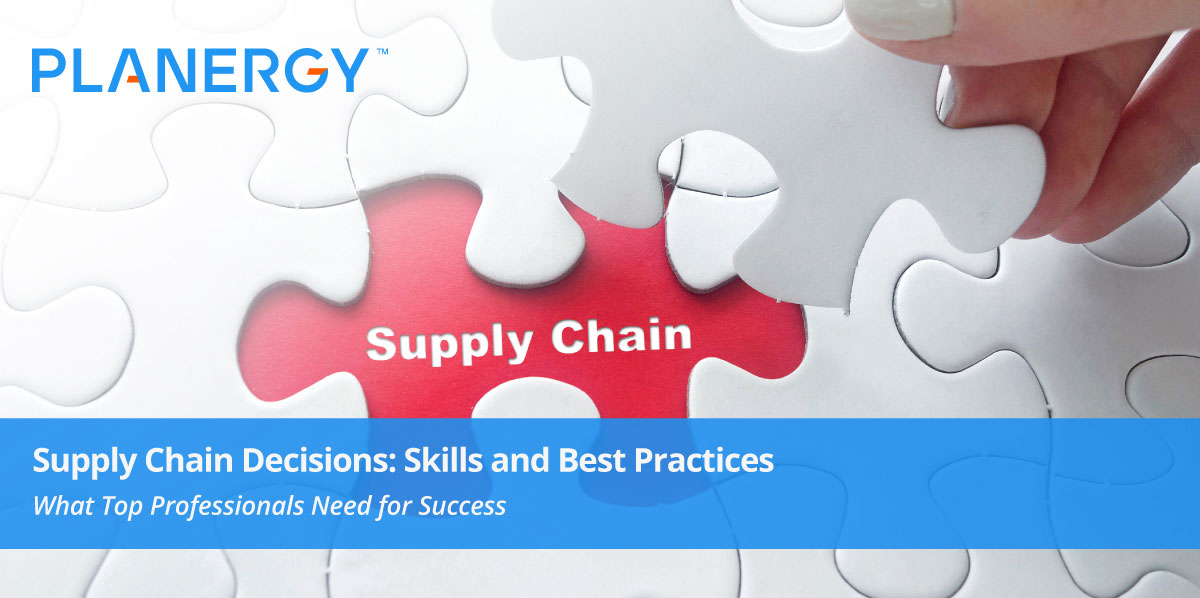The supply management decision-making process is complex. It involves many people across multiple teams.
As companies seek people to look over supply chain management (SCM), they look for people with effective decision-making skills.
This is even more important when it comes to managing a global supply chain.
Decision-making is important at all levels of the supply chain, so we’ll look at what those levels are, the importance of strong and effective decision-making at the strategic level, the skills you need, and the methodology you can use to make critical decisions efficiently.
Levels of Supply Chain Management Decisions
When it comes to supply chain management, there are three levels of operation.
Strategic
The strategic level is the top level of supply chain management. Here, they are responsible for the long-term decisions and laying the groundwork for the entire process.
Example decisions made at this level include deciding the products or services that the company will offer. It involves things like keeping track of customer feedback and current market trends.
Tactical
The tactical level of supply chain management involves the short-term and medium-term decisions throughout the supply chain. The strategic level addresses the big picture and general decisions.
This level starts defining the specific supply chain processes.
This is an area where manufacturing processes are designed to ensure that your company can maintain a high-quality product or service for the lowest possible cost.
Operational
At the operational level, most of the work takes place. It’s the day-to-day actions, decisions, and planning that keep the supply chain moving.
Many times, organizations fail to consider the strategic and tactical levels when making decisions at the operational level.
The Importance of Strategic Supply Chain Decision Making
Supply chain managers have to make difficult decisions, often fast, using real-time information. As such, it’s critical to have problem-solving skills that you can apply whenever you run into issues with your supply chain.
That small manufacturing issue can grow into a much bigger problem if your business doesn’t have effective procedures in place.
It’s not just efficient and effective decision-making that matters. Companies today need to focus efforts on ethical sourcing, not just saving money wherever possible.
Today’s consumers want to know that companies are doing their part to protect the environment and the people in it.
And since brand reputation influences where people spend their money, it can make or break your brand.
Solid decision-making skills in supply chain management aren’t just about challenges in logistics and manufacturing.
Changes in consumer perception and customer demand can also create issues with operation.
A single viral social media post could spur a spike in demand for a product.
As a supply chain manager, you have to determine how you can shift production schedules and rearrange your supply chain to meet the new demand.
The same can be said if a viral social media post has the opposite effect, causing a deep drop in demand.
Critical Skills for Supply Chain Professionals
There are several key decision-making skills that any sooner supply chain professional should have to be successful.
We include a list of 13 to help guide you along the decision-making process as a key stakeholder.
Identify Problems
The most successful supply chain pros spot potential problems before they become an issue.
Because it’s not always possible to see every problem ahead of time, you need to also be able to spot problems as they happen, so you can quickly find and implement fixes.
Develop and Communicate Solutions
In addition to being able to develop solutions for problems that come up, you need to be able to effectively communicate any changes in supply chain operations to everyone involved.
That could be informing and educating your team members about changes to the process, or communicating with outside suppliers in transportation, manufacturing, or warehousing. An aptitude for clear communication is essential.
Identify Trends and Opportunities
go to the dynamic nature of supply chains, you must keep your decision-making process and your leadership dynamic as well.
Instead of waiting for challenging situations to present themselves, monitor Trends in Supply chain management to keep yourself up-to-date with current best practices.
If you can find Opportunities to improve operations while creating plans to take advantage of those opportunities, your team can behave proactively which is always better than responding reactively.
Leverage Data and Technology
Data is your best friend. When you base your decision-making process on solid data, you’ll obviously be better equipped to make better choices, which gives you a competitive advantage.
Staying aware of the latest software Innovations helps improve job performance and ensures that your supply chain runs like a well-oiled machine is always a good thing.
Source and Generate Data
Of course, if you don’t have good data, to begin with, you won’t be able to leverage it to your advantage.
That’s why having a strong data collection and analysis system in place is also important.
Use automation to collect data from inventory management systems across multiple distributions centers.
Collect customer order data, raw materials order volume, etc.
Having the most accurate and current information is absolutely necessary for the problem-solving process, as it helps with forecasting and process optimization.
It also ensures that you are able to effectively allocate your team resources in ways that will help you accomplish your goals.
Incorporate Regulatory and Legal Considerations
Many factors outside your operation, and many outside of your control, will affect your supply chain.
Part of your job as a top professional is to keep yourself aware of both potential and actual changes to the regulatory and legal framework within each function of your supply chain.
Your long-term goal must account for any potential and actual changes in regulations and laws so that your operations can adapt to them accordingly.
Get Ideas from Team Members and Initiate Actions
When used correctly, your team is a vital asset to your decision-making process.
Gathering ideas for your team and then taking those ideas and turning them into actionable plans goes a long way to getting all team members on board with any operational changes. This is a high-level skill that your colleagues will appreciate.
Facilitate Collaboration from Outside Elements
All your internal team members are valuable, they aren’t the only piece of the puzzle.
Your effective communication skills should go beyond your internal team and extends to collaborating with the filament service providers, manufacturers, freight carriers, and any other external element in your supply chain. People at all stages of the supply chain can be resources to help you with solving your problems and implementing your decision.
Take advantage of your experience with your third-party partners to create a stronger, more robust, supply chain for your business.
Recognize Relative Importance and Prioritize
Unfortunately, supply chain management isn’t an area where you can focus on solving one problem at a time. Often, you’ll have more problems than you have time to solve.
That’s why it’s so essential for you to have experience end determining the relative importance of all of your priorities.
To be effective and successful, you have to assign a relative value to various competing factors.
That requires expertise to juggle everything and a complex supply chain.
Flexibility
The most successful supply chain managers are those who can think on their feet. Quick-thinking is essential when problems come up because it may be the only way to avoid interruptions that cost time and money.
Unpredictability is part of what makes your job exciting and challenging.
The better you are at making decisions at the spur of the moment, the better you can use your staff efforts while also reaching your organizational goals.
Use Past Experience to Guide Future Decisions
Taking time to really assess performance looking at both your failures and your successes, helps to ensure that you have better-informed decisions in the future. It is after all the key advantage of experience.
The better you’re able to draw from your past experience, the better you will be able to serve your team.
To prevent similar issues from coming up again, track your problems at every level of the supply chain including those that you can fix at the moment. The more data you track, the more metrics you can measure and assess as you go.
Know When to Adjust Course
Discernment can make or break you. You should always be willing to stand by a decision when you feel it’s the right one, even when others disagree with you.
But, you should also be willing to recognize when you’ve made the wrong choice and be willing to take action to change course if it becomes necessary.
Build Contingencies
Has anything in life ever come to you in the way you expected? We often view success as a straight line, when in reality, it’s full of curves, and even some setbacks.
Disruption is a fact that we cannot avoid, so it’s essential to account for the unknown.
Every decision you make needs to include a backup plan in case a change in circumstances renders your original plan useless.
Strategic decisions are crucial in procurement, but any decision may need to be changed as circumstances change.
Decision-Making Frameworks and Tools
as you practice the skills we’ve listed, you can also use decision-making strategies and tools to help you weigh the pros and cons of each situation that you may find yourself in.
These tools are designed to help you create processes for effective decision-making that you can apply in any applicable situation.
Rational Decision-Making Model
This is a simple 7-step process:
- Identify the problem or opportunity
- Identity possible solutions
- Conduct a gap analysis
- Gather data and explore alternative solutions
- Analyze the possible outcomes
- Choose the best solution for the situation at hand
- Put your plan into action
This works best when dealing with advanced problems so that you can consider all options and ramifications.
Pareto Analysis
This is based on the Pareto principle which basically states that 20% of your clientele accounts for 80% of your profit.
With a Pareto analysis, you apply the 80/20 rule to decision-making. This approach makes it easy for you to separate your important influences from the noise.
If you find that multiple factors have created a problem in the manufacturing sector of your supply chain, quantify the amount that each factor contributes to the issue.
You’re most likely to find that 20% of the factors cause 80% of the problem. As a result, you can clarify your decision-making process so that you are focusing on the most important factors first.
SWOT Analysis
SWOT stands for strengths, weaknesses, opportunities, and threats. this analysis helps you to see where your strengths and weaknesses are, along with opportunities that may be worth pursuing, and threats you may come across along the way.
Create a chart with two columns and two rows. In the first square, list your company’s strengths. In the second, list weaknesses. On the bottom, list your opportunities and then the threats.
Putting these factors down in a simple format allows you to quickly see pitfalls and opportunities that will help guide your problem-solving process.
Decision Tree
The decision tree is another visual mapping tool for decision-making. It can be helpful when it comes to predicting outcomes and weighing the pros and cons.
Right the situation on the top of a piece of paper. Draw branches to represent the factors that relate to the situation and the effects they caused.
Each branch may lead to additional branches that represent other factors, decision points, or consequences. The results of your decision tree can help you see which path may be better to take.
PEST Analysis
In a PEST analysis, you’re looking at the political, economic, social, and technology factors that may influence your supply chain.
This is a good visual tool to help you with decision-making because most Supply chains involve numerous external partners and cross multiple geopolitical borders.
This tool is especially helpful when it comes to setting your long-term goals.
Experience is the world’s greatest resource, but the right tools can set you apart from the rest.




